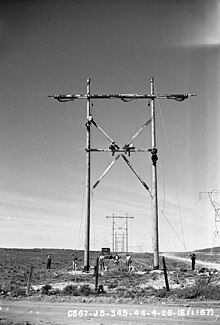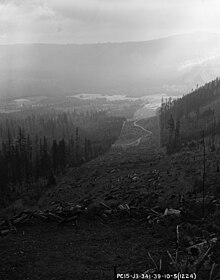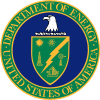 | |
| Agency overview | |
|---|---|
| Formed | August 20, 1937; 87 years ago (1937-08-20) |
| Jurisdiction | U.S. government |
| Headquarters | Portland, Oregon, U.S. |
| Agency executive |
|
| Parent agency | |
| Website | www |
The Bonneville Power Administration (BPA) is an American federal agency operating in the Pacific Northwest. BPA was created by an act of Congress in 1937 to market electric power from the Bonneville Dam located on the Columbia River and to construct facilities necessary to transmit that power. Congress has since designated Bonneville to be the marketing agent for power from all of the federally owned hydroelectric projects in the Pacific Northwest. Bonneville is one of four regional Federal power marketing agencies within the U.S. Department of Energy (DOE).

 Federal dam
Federal dam





Operations
The power generated on BPA's grid is sold to public utilities, private utilities, and industry on the grid. The excess is sold to other grids in Canada, California and other regions. Because BPA is a public entity, it does not make a profit on power sales or from providing transmission services. BPA also coordinates with the U.S. Army Corps of Engineers and the U.S. Bureau of Reclamation to regulate flow of water in the Columbia River and to carry out environmental projects such as salmon restoration.
Although BPA is part of the DOE, it is self-funded and covers its costs by selling its products and services at cost. The BPA provides about 28% of the electricity used in the region. BPA transmits and sells wholesale electricity in eight western states: Washington, Oregon, Idaho, Montana, Wyoming, Utah, Nevada, and California. Its minimum wholesale rate is 3.49 cents per kilowatt-hour; the BPA generated $4.72 billion in operating revenue in 2022.
BPA now markets the electricity from thirty-one federal hydroelectric dams on the Columbia River and its tributaries, as well as from the Columbia Generating Station, a nuclear plant located on the Hanford Site in eastern Washington. BPA has more than 15,000 circuit miles (24,140 circuit km) of electrical lines and 261 substations in the Pacific Northwest and controls approximately 75 percent of the high-voltage (230 kV and higher) transmission capacity in the region. 87 percent of the agency's sustained peak capacity (11,680 MW) is generated from hydroelectricity.
BPA also maintains connection lines with other power grids. It connects to the California high-voltage transmission system by Path 66, which consists of the two 500 kV AC lines of the Pacific AC Intertie, plus a third 500 kV AC line of the California-Oregon Transmission Project (COTP) (managed by the Balancing Authority of Northern California). Together these three lines are operated as the California-Oregon Intertie (COI) (managed by the California Independent System Operator CAISO). An additional DC ±500 kV line, the Pacific DC Intertie, links BPA's grid at the Celilo Converter Station near The Dalles, Oregon to the Los Angeles Department of Water and Power (LADWP) grid 800 miles (1,300 km) away at the Sylmar Converter Station in Los Angeles.
The Northern Intertie crosses the Canada–US border in two locations at Blaine, Washington and Nelway, British Columbia and connects to two BC Hydro AC 500 kV lines and several lower voltage lines.
Because BPA owns and operates transmission equipment and locations, its workers perform its own vegetation management.
BPA uses helicopters to sling load maintenance workers inspecting and repairing power lines.
Facilities and projects
The BPA is the designated marketer for 31 hydroelectric dams and the Columbia Generating Station a nuclear power plant at the Hanford Site. The dams are owned and operated by either the Army Corps of Engineers (21 dams) or the Bureau of Reclamation (10 dams), and have a maximum combined capacity of 22 GW.
| Dam | River | State(s) | Maximum capacity |
Year opened | Owner |
|---|---|---|---|---|---|
| Albeni Falls Dam | Pend Oreille | Idaho | 49 MW | 1955 | Army Corps of Engineers |
| Anderson Ranch Dam | Boise | Idaho | 40 MW | 1950 | Bureau of Reclamation |
| Big Cliff Dam | North Santiam | Oregon | 23 MW | 1953 | Army Corps of Engineers |
| Black Canyon Diversion Dam | Payette | Idaho | 10 MW | 1925 | Bureau of Reclamation |
| Boise River Diversion Dam | Boise | Idaho | 3 MW | 1912 | Bureau of Reclamation |
| Bonneville Dam | Columbia | Oregon, Washington | 1,216 MW | 1938 | Army Corps of Engineers |
| Chandler Dam | Yakima | Washington | 12 MW | 1956 | Bureau of Reclamation |
| Chief Joseph Dam | Columbia | Washington | 2,614 MW | 1958 | Army Corps of Engineers |
| Cougar Dam | McKenzie | Oregon | 28 MW | 1963 | Army Corps of Engineers |
| Detroit Dam | North Santiam | Oregon | 126 MW | 1953 | Army Corps of Engineers |
| Dexter Dam | Middle Fork Willamette | Oregon | 17 MW | 1954 | Army Corps of Engineers |
| Dworshak Dam | Clearwater | Idaho | 460 MW | 1973 | Army Corps of Engineers |
| Foster Dam | South Santiam | Oregon | 23 MW | 1967 | Army Corps of Engineers |
| Grand Coulee Dam | Columbia | Washington | 7,049 MW | 1942 | Bureau of Reclamation |
| Green Peter Dam | South Santiam | Oregon | 92 MW | 1967 | Army Corps of Engineers |
| Green Springs Dam | Emigrant Creek | Oregon | 17 MW | 1960 | Bureau of Reclamation |
| Hills Creek Dam | Middle Fork Willamette | Oregon | 34 MW | 1962 | Army Corps of Engineers |
| Hungry Horse Dam | Flathead | Montana | 428 MW | 1953 | Bureau of Reclamation |
| Ice Harbor Dam | Snake | Washington | 695 MW | 1962 | Army Corps of Engineers |
| John Day Dam | Columbia | Oregon, Washington | 2,484 MW | 1971 | Army Corps of Engineers |
| Libby Dam | Kootenai | Montana | 605 MW | 1975 | Army Corps of Engineers |
| Little Goose Dam | Snake | Washington | 930 MW | 1970 | Army Corps of Engineers |
| Lookout Point Dam | Middle Fork Willamette | Oregon | 138 MW | 1953 | Army Corps of Engineers |
| Lost Creek Dam | Rogue | Oregon | 56 MW | 1977 | Army Corps of Engineers |
| Lower Granite Dam | Snake | Washington | 930 MW | 1975 | Army Corps of Engineers |
| Lower Monumental Dam | Snake | Washington | 930 MW | 1969 | Army Corps of Engineers |
| McNary Dam | Columbia | Oregon, Washington | 1,127 MW | 1952 | Army Corps of Engineers |
| Minidoka Dam | Snake | Idaho | 28 MW | 1909 | Bureau of Reclamation |
| Palisades Dam | Snake | Idaho | 176 MW | 1958 | Bureau of Reclamation |
| Roza Dam | Yakima | Washington | 13 MW | 1958 | Bureau of Reclamation |
| The Dalles Dam | Columbia | Oregon, Washington | 2,048 MW | 1957 | Army Corps of Engineers |
History
The Bonneville Project, named for the then-new Bonneville Dam, was established by an act of Congress that was signed into law by President Franklin D. Roosevelt on August 20, 1936. The federal agency was created to market electricity from the Bonneville and Grand Coulee dams based on the model of the Tennessee Valley Authority (TVA). It would provide a flat rate for customer utilities and use revenue from these sales to pay off the bonds used by the federal government to finance the construction of dams in the Pacific Northwest. The agency's name was changed to the Bonneville Power Administration in 1940. Attempts to replace the BPA with a Columbia Valley Authority that more closely resembled the TVA were made in the 1940s and 1950s, but were ultimately unsuccessful.
BPA's first industrial sale was to Alcoa in January 1940, to provide 32,500 kilowatts of power. This, and the following 162,500 kilowatt order, led to complaints of the Bonneville Power Act's anti-monopoly clause. The cheap price of aluminum from Alcoa helped aluminum sales grow in the post-World War II market.
Overly optimistic estimates of future electricity consumption by BPA in the 1960s led the agency to guarantee some bonds for the disastrous Washington Public Power Supply System nuclear power project. Out of five nuclear power plants started (WNP-1 and WNP-4, WNP-3 and WNP-5), only WNP-2 was completed. BPA is still making payments on three of the abandoned plants. In 2003, BPA's debt for the nuclear project totaled $6.2 billion.
In 1973, the BPA commissioned TRW Inc. to write software for the PDP-10 mainframe computer that managed the agency's power grid; Bill Gates and Paul Allen wrote the software for the monitoring system, which remained in operation until its replacement in 2013.
In 2014, the BPA Library discovered a collection of old films made by the agency and began posting digital versions of them on the agency's website. Included in the collection is the award-winning documentary "River of Power" which covers the Agency's history from its beginning to the present.
The BPA gives its name to the BPA Trail in Federal Way, Washington, a walking trail built beneath power transmission lines.
Administrators
| Administrator | Dates |
|---|---|
| James D. (J. D.) Ross | Oct. 10, 1937 – March 14, 1939 |
| Charles Carey | Feb. 2 – May 4, 1939 (acting) |
| Frank Banks | May 4 – Sept. 15, 1939 (interim / acting) |
| Paul J. Raver | Sept. 16, 1939 – Jan. 14, 1954 |
| William A. Pearl | Jan. 15, 1954 – Feb. 14, 1961 |
| Charles F. Luce | Feb. 15, 1961 – Aug. 30, 1966 |
| David S. Black | Aug. 31, 1966 – Sept. 7, 1967 |
| H.R. Richmond | Sept. 8, 1967 – Oct. 19, 1967 (acting) |
| Donald P. Hodel | Dec. 1, 1972 – Dec. 19, 1977 |
| S. Sterling Munro, Jr. | Jan. 1978 – Feb. 1981 |
| Earl Gjelde | Feb. – May 1981 (acting) |
| Peter T. Johnson | May 1981 – July 1986 |
| James J. Jura | July 1986 – Aug. 1991 |
| Jack Robertson | Aug. – Oct. 1991 (acting) |
| Randall W. Hardy | Oct. 1991 – Sept. 1997 |
| Jack Robertson | Oct. 1997 – June 1998 (acting) |
| Judith A. Johansen | June 1998 – Sept. 2000 |
| Stephen J. Wright | Sept. 2000 – Feb. 2002 (acting) March 2002 – Feb. 2013 |
| William K. Drummond | Jan. 2013 – Jan. 2014 |
| Elliot Mainzer | July 2013 – Jan. 2014 (acting) Jan. 2014 – Sept. 2020 |
| John L. Hairston | Sept 2020 - Mar. 2021 (acting) Mar. 2021 – present |
Notes
- The position title varied in the early years as shown in the reference; since William Pearl, the title has consistently been 'Administrator of the Bonneville Power Administration'.
- The start date shown is the earliest date when the person was named to the position or when showed up for the job. The "effective" appointment date wasn't always precise but was always after the date of announcement, and sometimes before and sometimes after the date the individual actually began work on the job. Likewise, the swearing-in date was sometimes before and sometimes after the start of actual work in the position.
- Power administrator of the Bonneville Project
- During Ross' illness and after his death
- Administrator, Bonneville Power Project, later Bonneville Power Administration
See also
- Tennessee Valley Authority
- Power Marketing Administration
- Western Interconnection
- BPA Trail, Federal Way
References
- ^ "BPA Facts" (PDF). Bonneville Power Administration. March 2023. Retrieved June 5, 2024.
- "BPA to automate transmission curtailment procedure for the Puget Sound Area" (PDF). September 2007.
- Mason, Stacy L. (June 23, 2000). "Bonneville Power Administration Transmission System Vegetation Management Program Final Environmental Impact Statement (DOE/EIS-0285)". Bonneville Power Administration, U.S. Department of Energy, Bureau of Land Management (BLM), U.S. Forest Service (FS). Retrieved July 16, 2022.
- Head, Elan. "On The Line: Training with BPA and Priority 1 Air Rescue" Vertical, October 28, 2014. Accessed: October 30, 2014.
- Tate, Cassandra (April 27, 2015). "Bonneville Power Administration". HistoryLink. Retrieved June 5, 2024.
- "Bonneville Power Administration: History". Northwest Power and Conservation Council. Retrieved June 5, 2024.
- ^ MacColl, E. Kimbark (1979). The Growth of a City: Power and Politics in Portland, Oregon 1915–1950. Portland, Oregon: The Georgian Press. ISBN 0-9603408-1-5.
- Northwest Council: "BPA History" www.nwcouncil.org, accessed November 16, 2019
- Hair, Calley; Hastings, Patty (October 16, 2018). "Paul Allen honed his chops in Vancouver for BPA". The Columbian. Retrieved June 5, 2024.
- "Legacy computer system retires after keeping the lights on for 38 years". Bonneville Power Administration. Archived from the original on November 12, 2020. Retrieved November 16, 2019.
- Film-Vault www.bpa.gov, accessed November 16, 2019
- River of Power (1987) film www.bpa.gov/news, accessed November 16, 2019
- "Administrators of BPA". Bonneville Power Administration. Retrieved February 2, 2016.
Archives
- Charles F. Luce papers. 1654–2000. 6.13 cubic feet.
- Brock Adams papers. 1947–1993. 326.64 cubic feet (456 boxes).
- George H. Barker Collection of Dam Construction Photographs and Ephemera. 1935-1952. 243 photographic prints, 18 newspaper clippings (1 box).
External links
- Bonneville Power Administration
- Bonneville Power Administration in the Federal Register
- Historic American Engineering Record (HAER) documentation:
- HAER No. ID-22, "Bonneville Power Administration Burley Substation, 1221 Albion Avenue, Burley, Cassia County, ID", 13 photos, 19 data pages, 2 photo caption pages
- HAER No. OR-4, "Bonneville Power Administration South Bank Substation, I-84, South of Bonneville Dam Powerhouse, Bonneville, Multnomah County, OR", 20 photos, 9 data pages, 2 photo caption pages
- HAER No. WA-188, "Pasco-Kennewick Transmission Line, Columbia River Crossing Towers, Columbia Drive and Gum Street, Kennewick, Benton County, WA", 6 photos, 14 data pages, 1 photo caption page
![]() This article incorporates public domain material from BPA Fast Facts - Fiscal Year 2006 (PDF). United States Government. Archived from the original (PDF) on February 27, 2009.
This article incorporates public domain material from BPA Fast Facts - Fiscal Year 2006 (PDF). United States Government. Archived from the original (PDF) on February 27, 2009.
| United States Department of Energy | ||
|---|---|---|
| ||
| Deputy Secretary of Energy |  | |
| Under Secretary of Energy for Infrastructure | Office of Cybersecurity, Energy Security, & Energy Response | |
| Under Secretary of Energy for Nuclear Security | ||
| Under Secretary of Energy for Science and Innovation | ||
| Assistant Secretary of Energy for Nuclear Energy | Office of Nuclear Energy | |
| Power Marketing Administration | ||
| National Laboratory System | ||
| Energy Department Facilities and Reservations | ||
| Related Independent Agency | ||